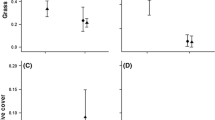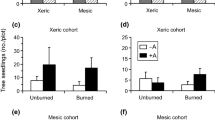Abstract
Plant communities developing in abandoned semi-natural areas are being increasingly dominated by invasive exotic species. How these ‘novel residents’ affect re-colonisation by native perennial species, a process generally assumed to be seed limited, remains little explored. We examined the relative roles of dominant exotic grasses and seed dispersal in limiting the richness and abundance of native perennial grasses in an old-field grassland community. We also tested whether native grass recruitment depended on the identity of resident exotic species. A seed addition, single-pulse removal experiment was established in a 20 year old field in the Inland Pampa of Argentina. Seeds of seven native perennial grasses from a nearby relict grassland were sown into intact and disturbed patches dominated by one of four exotic grasses. Species richness and biomass were measured after 2 years from sowing. Seed addition alone had little effect on native grass richness or biomass, with only one sown grass establishing in intact patches. Native grasses successfully colonised disturbed patches dominated by the exotics Lolium multiflorum, Cynodon dactylon or Sorghum halepense. In contrast, patches dominated by Festuca arundinacea repelled sown native grasses, regardless of disturbance treatment. Seed addition increased total plant richness in both disturbed and intact patches but did not affect total aboveground biomass. Our results show that recovery of native grasses during old-field succession is hierarchically constrained by seed arrival and site pre-emption by exotic grasses. Thus, re-establishment of native grass assemblages may only occur at the expense of displacing exotic resident plants. This highlights the importance of niche-limited species assembly in novel, native/exotic plant communities.





Similar content being viewed by others
References
Baer SG, Engle DM, Knops JMH, Langeland KA et al (2009) Vulnerability of rehabilitated agricultural production systems to invasion by nontarget plant species. Environ Manag 43:189–196
Baldi G, Guerschman JP, Paruelo JM (2006) Characterizing fragmentation in temperate South America grasslands. Agric Ecosyst Environ 116:197–208
Bender EA, Case TJ, Gilpin ME (1984) Perturbation experiments in community ecology: theory and practice. Ecology 65:1–13
Burkart SE, León RJC, Conde MC, Perelman SB (2011) High native diversity in remnant grasslands on productive soils of the cropping Pampa. Plant Ecol 212:1009–1024
Cabrera A, Zardini E (1978) Manual de la flora de los alrededores de Buenos Aires. ACME, Buenos Aires
Cheplick GP, Faeth SH (2009) Ecology and evolution of the grass-endophyte symbiosis. Oxford University Press, Oxford
Chesson P (2000) Mechanisms of maintenance of species diversity. Annu Rev Ecol Syst 31:343–366
Clark CJ, Poulsen JR, Levey DJ, Osenberg CW (2007) Are plant populations seed limited? A critique and meta-analysis of seed addition experiments. Am Nat 170:128–142
Connell JH, Slatyer RO (1977) Mechanisms of succession in natural communities and their role in community stability and organization. Am Nat 111:1119–1144
Corbin J, D’Antonio CM (2004) Competition between native perennial and exotic annual grasses: implications for a historic species invasion. Ecology 85:1273–1283
Cramer V, Hobbs R, Standish R (2008) What’s new about old fields? Land abandonment and ecosystem assembly. Trends Ecol Evol 23:104–112
Crawley MJ, Brown SL, Heard MS, Edwards GR (1999) Invasion-resistance in experimental grassland communities: species richness or species identity? Ecol Lett 2:140–148
D’Angela E, Facelli JM, Jacobo E (1988) The role of the permanent soil seed bank in early stages of a post-agricultural succession in the Inland Pampa, Argentina. Vegetation 74:39–45
Daehler CC (2003) Performance comparisons of co-occurring native and alien invasive plants: implications for conservation and restoration. Annu Rev Ecol Evol Syst 34:183–211
Daneshgar P, Jose S (2009) Role of species identity in plant invasions: experimental test using Imperata cylindrica. Biol Inv 11:1431–1440
Di Rienzo JA, Casanoves F, Balzarini MG, Gonzalez L, Tablada M, Robledo CW (2011) InfoStat versión 2011. Grupo InfoStat, FCA, Universidad Nacional de Córdoba, Argentina. URL http://www.infostat.com.ar
Dickson TL, Foster BL (2008) The relative importance of the species pool, productivity and disturbance in regulating grassland plant species richness: a field experiment. J Ecol 6:937–946
Didham RK, Tylianakis JM, Hutchinson MA, Ewers RM, Gemmerl RM (2005) Are invasive species the drivers of ecological change? Trends Ecol Evol 20:470–474
Emery SM, Gross KL (2006) Dominant species identity regulates invisibility of old-field plant communities. Oikos 115:549–558
Emery SM, Gross KL (2007) Dominant species identity, not community evenness, regulates invasion in experimental grassland plant communities. Ecology 88:954–964
Eriksson O, Ehrlén J (1992) Seed and microsite limitation of recruitment in plant populations. Oecologia 91:360–364
Facelli JM, Montero CM, León RJC (1988) Effect of different disturbance regimen on seminatural grasslands from the subhumid Pampa. Flora 180:241–249
Fargione J, Brown CS, Tilman D (2003) Community assembly and invasion: an experimental test of neutral versus niche processes. PNAS USA 100:8916–8920
Foster BL, Gross KL (1997) Partitioning the effects of plant biomass and litter on Andropogon gerardii in old field vegetation. Ecology 78:2091–2104
Foster B, Tilman D (2003) Seed limitation and the regulation of community structure in oak savanna grassland. J Ecol 91:999–1007
Foster BL, Dickson TL, Murphy CA, Karel IS, Smith VH (2004) Propagule pools mediate community assembly and diversity-ecosystem regulation along a grassland productivity gradient. J Ecol 92:435–449
Foster BL, Murphy KR, Keller TA, Aschenbach EJ, Questad M, Kindscher K (2007) Restoration of prairie community structure and ecosystem function in an abandoned hayfield: a sowing experiment. Rest Ecol 15:652–661
Funk JL, Cleland EE, Suding KN, Zavaleta ES (2008) Restoration through reassembly: plant traits and invasion resistance. Trends Ecol Evol 23:695–703
Gibson DJ (2009) Grasses and grassland ecology. Oxford University Press, Oxford
Grime JP (1974) Vegetation classification by reference to strategies. Nature 250:26–31
Grime JP (2001) Plant strategies, vegetation processes and ecosystem properties. Wiley, Amsterdam
Hierro JL, Callaway RM (2003) Allelopathy and exotic plant invasion. Plant Soil 256:29–39
Hobbs RJ, Arico S, Aronson J, Baron JS et al (2006) Novel ecosystems: theoretical and management aspects of the new ecological world order. Global Ecol Biogeogr 15:1–7
Hodgson JG, Wilson PJ, Hunt R, Grime JP, Thompson K (1999) Allocating CSR plant functional types: a soft approach to a hard problem. Oikos 85:282–294
Kulmatiski A (2006) Exotic plants establish persistent communities. Plant Ecol 187:261–275
Levine J, Vila M, D’Antonio CM, Dukes JS, Grigulis K, Lavorel S (2003) Mechanisms underlying the impacts of exotic plant invasions. Proc R Soc Lond B 270:775–781
Loreau M, Naeem S, Inchausti P et al (2001) Biodiversity and ecosystem functioning: current knowledge and future challenges. Science 294:804–808
MacDougall AS, Turkington R (2005) Are invasive species the drivers or passengers of change in degraded ecosystems? Ecology 86:42–55
Maron JL, Gardner SN (2000) Consumer pressure, seed vs. safe-site limitation, and plant population dynamics. Oecologia 124:260–269
McCune B, Mefford MJ (1999) PC-Ord windows. MjM Software, Gleneden Beach
Meiners S, Picket STA, Cadenasso M (2002) Exotic plant invasions over 40 years of old field successions: community patterns and associations. Ecography 25:215–223
Minchin PR (1987) An evaluation of the relative robustness of techniques for ecological ordination. Plant Ecol 69:89–107
Münzbergová Z, Herben T (2005) Seed, dispersal, microsite, habitat and recruitment limitation: identification of terms and concepts in studies of limitations. Oecologia 145:1–8
Myers JA, Harms KE (2009) Seed arrival, ecological filters, and plant species richness: a meta-analysis. Ecol Lett 12:1250–1260
Myers JA, Harms KE (2011) Seed arrival and ecological filters interact to assemble high-diversity plant communities. Ecology 92:676–686
Omacini M, Chaneton EJ, León RJC, Batista WB (1995) Old-field successional dynamics on the Inland Pampa, Argentina. J Veg Sci 6:309–316
Orrock JL, Witter MS, Reicheman OJ (2009) Native consumers and seed limitation constrain the restoration of a native perennial grass in exotic habitats. Restor Ecol 17:148–157
Pacala S, Rees M (1998) Models suggesting field experiments to test two hypotheses explaining successional diversity. Am Nat 152:729–737
Poggio SL, Chaneton EJ, Ghersa CM (2010) Landscape complexity differentially affects alpha, beta, and gamma diversities of plants occurring in fencerows and crop fields. Biol Conserv 143:2477–2486
Potthoff M, Steenwerth K, Jackson L, Drenovsky R, Scow K, Joergensen R (2009) Soil microbial community composition as affected by restoration practices in California grassland. Soil Biol Biochem 36:1851–1860
Ricklefs RE, Schluter D (1993) Species diversity in ecological communities: historical and geographical perspectives. University of Chicago Press, Chicago
Seabloom EW (2011) Spatial and temporal variability in propagule limitation of California native grasses. Oikos 120:291–301
Seabloom EW, Harpole S, Reichman OJ, Tilman D (2003) Invasion, competitive dominance, and resource use by exotic and native California grassland species. PNAS USA 100:13384–13389
Simberloff D (2010) Invasions of plant communities: more of the same, something very different, or both? Am Mid Nat 163:220–233
Soons MB, Heill GW, Nathan R, Katul GG (2004) Determinants of long-distance seed dispersal by wind in grasslands. Ecology 85:3056–3068
Soriano A (1992) Río de la Plata grasslands. In: Coupland RT (Ed) Natural grasslands: introduction and western hemisphere. Ecosystems of the World 8 A. Elsevier, Amsterdam pp 367–407
Standish RJ, Cramer VA, Wild SL, Hobbs RJ (2007) Seed dispersal and recruitment limitation are barriers to native recolonization of old-fields in western Australia. J Appl Ecol 44:435–445
Steel RGD, Torrie JH (1980) Principles and Procedures of Statistics: a Biometrical Approach. McGraw-Hill, New York
Stein C, Auge H, Fischer M, Weisser WW, Prati D (2008) Dispersal and seed limitation affect diversity and productivity of montane grasslands. Oikos 117:1469–1478
Symstad AJ, Tilman D, Willson J, Knops JMH (1998) Species loss and ecosystem functioning: effects of species identity and community composition. Oikos 81:389–397
Tilman D (1993) Species richness of experimental productivity gradients: how important is colonization limitation? Ecology 74:2179–2191
Tognetti PM, Chaneton EJ, Omacini M, Trebino HJ, León RJC (2010) Exotic vs. native plant dominance over 20 years of old-field succession on set-aside farmland in Argentina. Biol Cons 143:2494–2503
Turnbull L, Crawley MJ, Rees M (2000) Are plant populations seed-limited? A review of seed sowing experiments. Oikos 88:225–238
Vilá M, Espinar JL, Hejda M, Hulme PE et al (2011) Ecological impacts of invasive alien plants: a meta-analysis of their effects on species, communities and ecosystems. Ecol Lett 14:702–708
Wilsey BJ, Polley HW (2003) Effects of seed additions and grazing history on diversity and productivity of subhumid grasslands. Ecology 84:920–931
Wilsey BJ, Teaschner TB, Daneshgar PP, Isbell FI, Polley HW (2009) Biodiversity maintenance mechanisms differ between native and novel exotic-dominated communities. Ecol Lett 12:432–442
Wilsey BJ, Daneshgar PP, Polley HW (2011) Biodiversity, phenology and temporal niche differences between native and novel exotic-dominated grasslands. Perspect Plant Ecol Evol Syst 13:265–276
Wolkovich EM, Cleland EE (2011) The phenology of plant invasions: a community ecology perspective. Front Ecol Environ 9:287–294
Zobel M, Otsus M, Liira J, Moora M, Möls T (2000) Is small-scale species richness limited by seed availability or microsite availability? Ecology 81:3274–3282
Acknowledgments
We thank the staff at Estancia San Claudio for logistic assisstance throughout this project. Two anonymous reviewers provided helpful comments to improve the manuscript. The study was funded by the University of Buenos Aires (grants no. G-024 and G-046). PMT was supported by a doctoral fellowship from Consejo Nacional de Investigaciones Científicas y Técnicas (CONICET) Argentina.
Author information
Authors and Affiliations
Corresponding author
Electronic supplementary material
Below is the link to the electronic supplementary material.
Rights and permissions
About this article
Cite this article
Tognetti, P.M., Chaneton, E.J. Invasive exotic grasses and seed arrival limit native species establishment in an old-field grassland succession. Biol Invasions 14, 2531–2544 (2012). https://doi.org/10.1007/s10530-012-0249-2
Received:
Accepted:
Published:
Issue Date:
DOI: https://doi.org/10.1007/s10530-012-0249-2




